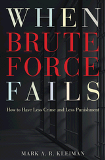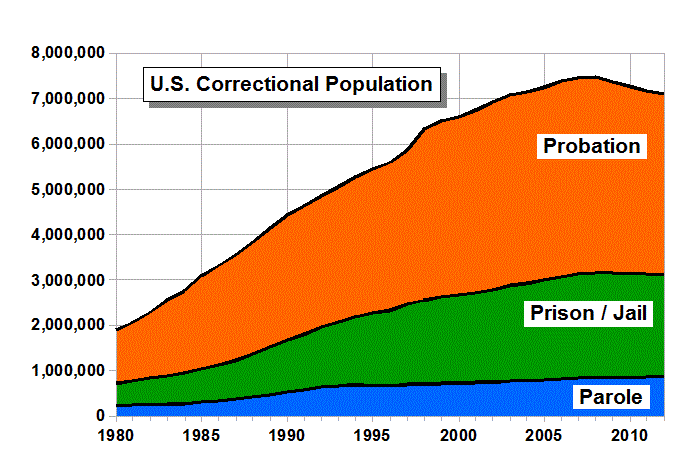October 1, 2009
Private: On Crime: Being Smart vs. Being Tough
HOPE Probation Program, Mark Kleiman, Mass Incarceration, Smart on Crime, When Brute Force Fails

Crime, even after a decade of falling crime rates, remains a huge problem, and a major barrier to improving conditions in poor neighborhoods. Mass incarceration - one American adult in 100 is now behind bars - constitutes a problem in its own right. The challenge we face is how to shrink both problems at the same time.
[Click the graph at right to zoom.]

But not the way either liberals or conservatives normally think about the problem: not by building more prisons or "fixing root causes," not through "zero tolerance" or "restorative justice," not by "winning the drug war" or "ending prohibition," not with "more guns, less crime" or national gun registration.
The current system of randomized severity gets us the worst of all possible worlds: high crime rates and mass incarceration.
The alternative approach that could cut both crime and incarceration rates depends on a few principles, simple in concept but requiring effective management:
• Punishment is a cost, not a benefit.
• Swiftness and certainty are more effective than severity.
• A truly convincing threat doesn't have to be carried out very often.
• A small proportion of the offenders account for most of the crime.
• Offenders need to be warned - personally and specifically - what it is that they're not supposed to do and what will happen if they keep doing it.
• Concentrating enforcement attention works better than dispersing it.
• Now that it's possible to monitor the location and drug use of probationers and parolees, many - perhaps most - of today's prisoners could be safely managed in the community instead. But that depends on the willingness and capacity to use short jail stays, delivered quickly and reliably, to sanction probation and parole violations.
• The primary goal of drug law enforcement should be to minimize crime and disorder around the drug markets, not to reduce the flow of drugs.
• Not every social program helps control crime. But some demonstrably do: nurse home visits, improved classroom discipline, shifting the school day later so that adolescents aren't on the streets when there are lots of empty homes, reducing exposure to lead, substitution therapy (methadone and buprenorphine) for opiate addicts.
• Social-services agencies need to be managed with crime control in mind, just as criminal-justice agencies need to be managed to help control disease and serve other non-crime-control purposes.
Hawaii's HOPE probation program illustrates how this approach plays out in practice. In Hawaii, as in California, neither judges nor probation officers want to revoke probation and send a probationer to prison for "technical" violations of probation terms. Consequently, probationers quickly learn what they can get away with: roughly, anything short of getting arrested for a new crime. In particular, drug users learn that the most likely result of failing a drug test is a warning from the probation officer. As a result, probationers keep using expensive drugs, which often means going to prison for the crimes they commit to pay for those drugs.
But a judge in Hawaii had a better idea. He took a group of methamphetamine-using probationers who wouldn't stop using their favorite drug, and put them on randomized drug testing, with the promise that every missed or "dirty" test would lead to an immediate 48-hour spell behind bars. Once that threat had been clearly made, most probationers stopped using. Of those who got caught once and spent their two days in jail, fewer than half broke the rules again. That simple step cut the number of probationers arrested for new crimes, and the number sent off to prison, by two-thirds.
In High Point, North Carolina, police had been trying and failing for twenty years to control an open crack market. Every time a dealer was arrested, a new dealer took his place. But then the police accumulated cases against all the active dealers, and called them in for a meeting. The police chief issued a simple message: stop dealing right now, or go to prison. That drove most of the dealers away immediately; the one who decided to test the system was arrested and sent away. With all the dealers gone, the customers stopped coming, and the market dried up. Five years later, it's still gone.
Poor parenting creates children at high risk of becoming serious criminals. A baby doesn't come with an instruction manual. Sending nurses to the homes of first-time mothers who are also poor and young can markedly improve the lives of their children and reduce their probability of being arrested by more than 25 percent. That may be the most cost-effective crime-control program ever invented, since the cost of sending out the nurses is more than covered by reduced costs elsewhere in the health care system due to the fact that the children don't get sick as often. One provision of the current health care bill would promote such programs, but the Heritage Foundation opposes it as government intrusion into the family.
After four decades of being "tough on crime," it's time to get smart instead. We need to be as tough as necessary, but no tougher. The goal is not to put as many people behind bars as possible, but to make people safer in their homes, workplaces, and neighborhoods. Professionals throughout the criminal justice system are figuring out how to do that; it's time for the public conversation to catch up with what the experts know.
Criminal Justice, Prison Policy/Incarceration, Sentencing Guidelines




